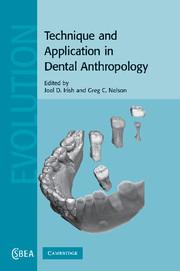Book contents
- Frontmatter
- Contents
- Contributors
- Acknowledgments
- Section I Context
- Section II Applications in assessing population health
- Section III Applied life and population history
- Section IV Forefront of technique
- 15 Methods of ingestion and incisal designs
- 16 Dental reduction in Late Pleistocene and Early Holocene hominids: alternative approaches to assessing tooth size
- 17 Dental microwear analysis: historical perspectives and new approaches
- 18 Virtual dentitions: touching the hidden evidence
- Index
- References
18 - Virtual dentitions: touching the hidden evidence
Published online by Cambridge University Press: 12 September 2009
- Frontmatter
- Contents
- Contributors
- Acknowledgments
- Section I Context
- Section II Applications in assessing population health
- Section III Applied life and population history
- Section IV Forefront of technique
- 15 Methods of ingestion and incisal designs
- 16 Dental reduction in Late Pleistocene and Early Holocene hominids: alternative approaches to assessing tooth size
- 17 Dental microwear analysis: historical perspectives and new approaches
- 18 Virtual dentitions: touching the hidden evidence
- Index
- References
Summary
Introduction
Recent advances in dental developmental biology, quantitative genetics, and micro-anatomy (e.g. Dean, 2000, 2006; Hlusko, 2004; Hlusko et al., 2004; Jernvall, 2000; Jernvall and Jung, 2000; Mitsiadis and Smith, 2006; Olejniczak et al., 2004; Pereira et al., 2006; Smith T. M., 2006; Smith T. M. et al., 2006a; Thesleff et al., 2001) have made clear that a critical amount of structural data is preserved in primate dental tissues. Such data can be used to reconstruct/assess evolutionary pathways and phylogenetic relationships, adaptive strategies, growth rates and developmental timing, and age- and sex-related variation patterns in fossil taxa; they may even be used to tentatively outline aspects of their life-history, including fluctuating health conditions and seasonally related individual–environment dynamic relationships recorded during growth (Beynon et al., 1998; Chaimanee et al., 2006; Dean and Leakey, 2004; Dean et al., 2001; FitzGerald et al., 2006; Guatelli-Steinberg et al., 2005; Kelley and Smith, 2003; Lacruz et al., 2006; Macchiarelli et al., 2006; Marivaux et al., 2006a; Ramirez-Rozzi and Bermúdez de Castro, 2004; Schwartz et al., 2003; Smith P. et al., 2006; Smith T. M. et al., 2005a, 2006b; Sponheimer et al., 2006). Nonetheless, a significant portion of this valuable paleobiological archive is hidden deep within the crown and root(s). Since it is not possible or, in the case of scarce fossils, desirable to section every specimen, non-invasive analytical approaches can be used in addition to histomorphometry.
- Type
- Chapter
- Information
- Technique and Application in Dental Anthropology , pp. 426 - 448Publisher: Cambridge University PressPrint publication year: 2008
References
- 23
- Cited by

